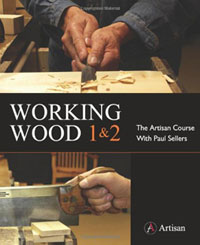
BOOK REVIEW:
Working Wood 1 & 2 - The Artisan Course with Paul Sellers
by J. Norman Reid
Delaplane, VA
In
Working Wood 1 & 2
, Paul Sellers has produced an excellent guide to woodworking
with hand tools. A master craftsman with 40 years experience in working with wood
and two decades teaching his methods to thousands of students, Sellers shares his
knowledge about the techniques of hand tool woodworking and the skills needed to
succeed at it. With the eye of a practiced teacher, he covers all the essentials—how to
use the tools, reading the wood, joint making and sharpening. He does this while
providing guidance on building a series of interesting projects that, while they
progressively develop hand tool skills, result in products that themselves are worthwhile.
In the introductory section, Sellers stresses the importance of three areas of skill
needed for successful hand tool woodworking—accuracy, sharpness and technique.
These are combined with four knowledge areas: materials and their properties; design
and structure; methods and procedures; and tools and techniques. The introduction
continues with an overview of types of shaping wood—by reduction or reforming—and
of joinery. A brief review of wood's properties follows.
The meat of the book, and the part that will interest readers most, begins with a
discussion of the tools most needed by the hand tool woodworker. Sellers himself is a
minimalist, seemingly preferring restored tools over the freshly-made as a way to keep
woodworking affordable and in later sections he gives guidance on restoring and setting
up older handplanes, among other tools.
Sellers urges woodworkers to begin their hand tool woodworking by practicing shaping,
using such tools as chisels, gouges and spokeshaves to convert blocks of wood into
useful objects. Among those he illustrates are spatulas, spoons, cutting boards, carved
bowls and a three-legged stool.
Sellers next provides instruction on three types of joinery, which he argues can be
created with a minimal set of only 10 tools. The joints—which he argues are all you
need to be able to make—are housing dados, dovetails and mortises and tenons. In
this section he shows how the reader can make a template for laying out dovetails and
he shows easy methods for cutting dovetails and chopping mortises, among other
techniques.
Next come a series of projects that will give the woodworker experience in creating
each of these joints. First is a dovetailed Shaker box that incorporates a hand-shaped
base and lid. Importantly, he illustrates how to cut the hinge mortises accurately.
Second is a four-shelf wall unit. Though his example is intended to be hung on the wall,
the project can be easily resized as a full-length bookcase if desired. This project
expands the woodworker's skills by practicing haunched mortises and tenons, through
tenons, housed dados and arched rails.
The next project is a chairside table, similar to the familiar Shaker table. This one
differs from the Shaker pattern by incorporating arched aprons and shaped rather than
tapered legs. It employs haunched mortises and tenons for added strength. Sellers
demonstrates the use of a shop-made mortise guide to assure that the mortise walls are
square. And he shows several methods for cutting the tenons.
The final project is a European workbench build from home center lumber, laminated to
create a solid top and incorporating a tool well and wide aprons that add considerable
stability to the bench. The construction includes haunched mortises and tenons and
housed dados. Sellers shows how to install a vise to the bench, equipment he finds
indispensable to the hand tool woodworker.
The final portion of the book is given over to sharpening. Sellers emphasizes again and
again the fact that sharp tools are essential to quality hand tool woodworking and that
skills in sharpening are necessary as a result. At the same time, he presents
sharpening methods that reduce the seemingly burdensome nature of this critical chore.
For edge tools—chisels, gouges and plane blades—he uses a series of diamond plates
followed by a strop with 15,000 polishing paste. He presents techniques for sharpening these tools, as well as spokeshaves, handsaws, scrapers and drill bits. A special
section addresses restoring and tuning handplanes. Especially useful are charts for
troubleshooting problems with handplanes, spokeshaves and scrapers.
Sellers' book is an excellent guide to learning and practicing basic hand tool
woodworking. The projects included in the book are well chosen to help the
woodworker build his or her skills in addition to being interesting in their own right.
For those who are visually-oriented and learn best by seeing, you can also purchase
the set of DVDs
that accompany the book and are an outstanding teaching tool. Although the
transitions between topics on the videos are often overproduced and sometimes
annoying, the actual training segments with Sellers are, in my judgment, essential to
getting the full value from this resource. The book is itself is lavishly illustrated and easy
to follow. Nonetheless, the DVDs show nuances of technique that are impossible to
easily convey in words and the careful woodworker will get the most by studying both
the book and the DVDs.
This book and DVDs will be especially useful to beginning and intermediate hand tool
woodworkers. Anyone who wants to learn more about hand tool sharpening, setup and
use, about hand tool techniques to achieve accuracy and precision, or who simply
wants to build some interesting projects by hand will find these resources to be
valuable.
CLICK HERE to order your copy of
Working Wood 1 and 2
The Artisan Course with Paul Sellers
CLICK HERE to order the book plus the set of 7 DVDs
J. Norman Reid is a woodworker, writer, and woodworking instructor living with his wife in the foothills of the Blue Ridge Mountains with a woodshop full of power and hand tools and four cats who believe they are cabinetmaker's assistants.
He can be reached by email at
nreid@fcc.net
.
Return to
Wood News
front page


